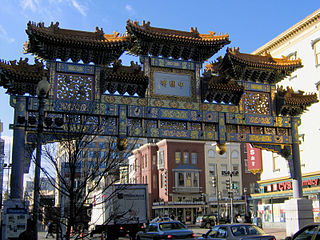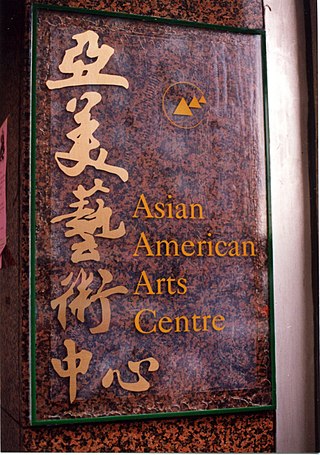Related Research Articles

Manhattan's Chinatown is a neighborhood in Lower Manhattan, New York City, bordering the Lower East Side to its east, Little Italy to its north, Civic Center to its south, and Tribeca to its west. With an estimated population of 90,000 to 100,000 people, Chinatown is home to the highest concentration of Chinese people in the Western Hemisphere. Manhattan's Chinatown is also one of the oldest Chinese ethnic enclaves. The Manhattan Chinatown is one of nine Chinatown neighborhoods in New York City, as well as one of twelve in the New York metropolitan area, which contains the largest ethnic Chinese population outside of Asia, comprising an estimated 893,697 uniracial individuals as of 2017.

Washington, D.C.'s Chinatown is a small, historic area east of Downtown Washington, D.C. along H and I Streets between 5th and 8th Streets, Northwest. Historically, the area was once home to thousands of Chinese immigrants, which had shrunk to fewer than 300 in 2017. The current neighborhood was the second in Washington to be called “Chinatown” since 1931. Originally, the first Chinatown was built in the Federal Triangle on the south side of Pennsylvania Avenue some time after 1851, but was relocated to the H Street area when a new federal building was built there. A Chinese gate was built over H Street at 7th Street. By 1997, prominent landmarks such as the Capital One Arena, a sports and entertainment arena, had gentrified the area. The neighborhood is served by the Gallery Place station of the Washington Metro.

The Asian American Legal Defense and Education Fund (AALDEF) is a New York-based national organization founded in 1974 that seeks to protect and promote the civil rights of Asian Americans. By combining litigation, advocacy, education, and organizing, AALDEF works with Asian American communities across the country to secure human rights for all.

Little Fuzhou is a neighborhood in the Two Bridges and Lower East Side areas of the borough of Manhattan in New York City. Little Fuzhou constitutes a portion of the greater Manhattan Chinatown, home to the highest concentration of Chinese people in the Western Hemisphere. Manhattan's Chinatown is also one of the oldest Chinese ethnic enclaves. The Manhattan Chinatown is one of nine Chinatown neighborhoods in New York City, as well as one of twelve in the New York metropolitan area, which contains the largest ethnic Chinese population outside of Asia, comprising an estimated 893,697 uniracial individuals as of 2017. Starting in the 1980s and especially in the 1990s, the neighborhood became a prime destination for immigrants from Fuzhou, Fujian, China. Manhattan's Little Fuzhou is centered on East Broadway. However, since the 2000s, Chinatown in the neighborhood of Sunset Park became New York City's new primary destination for the Fuzhou immigrants, surpassing the original enclave in Manhattan.

The Asian American Arts Centre (AAAC) is a non-profit organization located in Chinatown in New York City. Founded in 1974, it is one of the earliest Asian American community organizations in the United States. The Arts Centre presents the ongoing developments between contemporary Asian & Asian American art forms and Western art forms through the presentation of performance, exhibitions, and public education. AAAC's permanent collection, which it has accumulated since 1989, contains hundreds of contemporary Asian American art works and traditional/folk art pieces. The organization also has an Artists Archive which documents, preserves, and promotes the presence of Asian American visual culture in the United States since 1945. This includes the East Coast, especially the greater New York area; the West Coast; and some artists in Canada, Hawaii, and overseas. The artists include Asian Americans producing art, Asian artists who are active in the United States, and other Americans who are significantly influenced by Asia. Pan-Asian in outlook, the Arts Centre's understanding of ‘Asia’ encompasses traditions and influences with sources ranging from Afghanistan to Hawaii.
Godzilla: Asian American Arts Network was a New York-based Asian American arts collective and support network established in 1990. Founding members Ken Chu, Bing Lee, Margo Machida, and others established Godzilla in order to facilitate inter-generational and interdisciplinary dialogue and collaboration for Asian American artists and art professionals. The collective provided visibility in local and national exhibitions, developed press outreach strategies, published newsletters, and sponsored symposia on Asian American art. It was disbanded in 2001.

The first Brooklyn Chinatown, was originally established in the Sunset Park area of the New York City borough of Brooklyn. It is one of the largest and fastest growing ethnic Chinese enclaves outside of Asia, as well as within New York City itself. Because this Chinatown is rapidly evolving into an enclave predominantly of Fuzhou immigrants from Fujian Province in China, it is now increasingly common to refer to it as the Little Fuzhou or Fuzhou Town of the Western Hemisphere; as well as the largest Fuzhou enclave of New York City.
Akiko Ichikawa is a transdisciplinary artist, editor, and writer-activist based in New York City. She has written on contemporary art and culture for Flash Art,Art in America, Hyperallergic, and zingmagazine. Ichikawa's article on the photography of Dorothea Lange, Toyo Miyatake, and Ansel Adams at Manzanar became popular in fall 2016, following comments by a spokesperson of a Trump-supporting PAC on Fox News.
The gentrification of Vancouver, Canada, has been the subject of debate between those who wish to promote gentrification and those who do not.
Laura Owens is an American painter, gallery owner and educator. She emerged in the late 1990s from the Los Angeles art scene. She is known for large-scale paintings that combine a variety of art historical references and painterly techniques. She lives and works in Los Angeles, California.

East Broadway is a two-way east–west street in the Chinatown, Two Bridges, and Lower East Side neighborhoods of the New York City borough of Manhattan.
Tomie Arai is an American artist and community activist who was born, raised, and is still active in New York City. Her works consist of multimedia site specific art pieces that deal with topics of gender, community, and racial identity. She is highly involved in community discourse, and co-founded the Chinatown Art Brigade.

There are multiple Chinatowns in the borough of Queens in New York City. The original Queens Chinatown emerged in Flushing, initially as a satellite of the original Manhattan Chinatown, before evolving its own identity, surpassing in scale the original Manhattan Chinatown, and subsequently, in turn, spawning its own satellite Chinatowns in Elmhurst, Corona, and eastern Queens.
Tiffany Chung is a Vietnamese American multimedia artist based in Houston, Texas. Chung is globally noted for her interdisciplinary and research-based practice, with cartographic works and installations that examine conflict, geopolitical partitioning, spatial transformation, environmental crisis, displacement, and forced migration, across time and terrain.

The gentrification of San Francisco has been an ongoing source of tension between renters and working people who live in the city as well as real estate interests. A result of this conflict has been an emerging antagonism between longtime working-class residents of the city and the influx of new tech workers. A major increase of gentrification in San Francisco has been attributed to the Dot-Com Boom in the 1990s, creating a strong demand for skilled tech workers from local startups and close by Silicon Valley businesses leading to rising standards of living. As a result, a large influx of new workers in the internet and technology sector began to contribute to the gentrification of historically poor immigrant neighborhoods such as the Mission District. During this time San Francisco began a transformation eventually culminating in it becoming the most expensive city to live in the United States.

Chloë Bass is an American conceptual artist who works in performance and social practice. Bass' work focuses on intimacy. She was a founding co-lead organizer of Arts in Bushwick from 2007-2011, the group that organizes Bushwick Open Studios. She is an Assistant Professor of Art and Social Practice at Queens College, CUNY, and holds a BA from Yale University and an MFA from Brooklyn College. Bass was a regular contributor to Hyperallergic until 2018.
Cityarts Workshop was a nonprofit community mural arts organization incorporated in 1971. Cityarts Workshop often employed lead artists to work within various communities to create murals. In the 1970, Cityarts Workshop created several murals by and for communities of color, three of which were in Chinatown with lead artists Tomie Aria and Alan Okada.

Decolonize This Place is a movement based in New York City that organizes around Indigenous rights, black liberation, Palestinian nationalism, de-gentrification, and economic inequality. Their actions often take place at museums and cultural institutions and focus on colonialist tendencies within the art world.
Joyce Yu-Jean Lee is a visual artist working with video, photography, interactive installation and performance that combine social practice, institutional critique and activism together in an interdisciplinary practice. She is the founder of FIREWALL Internet Cafe social software consisting of a Google and Baidu dual-search engine that garnered backlash from Chinese state authorities in 2016.
FIREWALL Internet Café is an art project founded in 2016 by visual artist Joyce Yu-Jean Lee as a socially engaged research and interactive art project about Internet censorship. The not-for-profit goal of FIREWALL is to investigate online censorship and foster public dialogue about Internet freedom.
References
- 1 2 3 4 "Chinatown Art Brigade | Whitney Museum of American Art". whitney.org. Retrieved 2018-03-19.
- ↑ avanyur (2017-06-09). "(ex)CHANGE: History Place Presence". The Pew Center for Arts & Heritage. Retrieved 2018-03-28.
- 1 2 3 "Art and activism in Manhattan's gentrifying Chinatown". soft city. Archived from the original on 2018-03-29. Retrieved 2018-03-28.
- 1 2 3 4 5 "FABnyc Storefront Artists in Residence: Chinatown Art Brigade". Fourth Arts Block. 2018-01-25. Archived from the original on 2018-03-29. Retrieved 2018-03-28.
- 1 2 3 4 5 6 "2017 Spring Fellow: Chinatown Art Brigade". Culture Push. Archived from the original on 2018-03-28. Retrieved 2018-03-28.
- 1 2 3 4 "About the Brigade". Chinatown Art Brigade. Archived from the original on 2018-03-20. Retrieved 2018-03-14.
- ↑ "Here to Stay". Chinatown Art Brigade. Archived from the original on 2018-03-22. Retrieved 2018-03-14.
- 1 2 "Art and activism in Manhattan's gentrifying Chinatown". soft city. Archived from the original on 2018-03-29. Retrieved 2018-03-28.
- 1 2 "Chinatown Art Brigade - A Blade of Grass". A Blade of Grass. Retrieved 2018-03-28.
- 1 2 3 4 "Gentrification, the Art Gallery Influx, and Other Pressures on Manhattan's Chinatown". Hyperallergic. 2016-10-07. Retrieved 2018-03-28.
- ↑ "About Me". Betty Yu. Retrieved 2018-03-14.
- ↑ "Tomie Arai, ManSee Kong, Betty Yu - Lower Manhattan Cultural Council". Lower Manhattan Cultural Council. Retrieved 2018-03-14.
- ↑ "'Chinatown Art Brigade' Takes a Stand with Anti-Gentrification Projections [INTERVIEW]". Bowery Boogie. 2016-09-30. Archived from the original on 2022-08-19. Retrieved 2018-03-14.
- ↑ "Vision and Values". Chinatown Art Brigade. Archived from the original on 2018-03-22. Retrieved 2018-03-14.
- ↑ "Our Squad". Chinatown Art Brigade. Archived from the original on 2018-03-22. Retrieved 2018-03-14.
- ↑ "2016". Asian Women Giving Circle. 2017-02-05. Retrieved 2018-03-28.
- ↑ "ARTnews: Rubin Foundation Awards Grants to 60 Organizations Aligned with Art and Social Justice - Rubin Foundation". Rubin Foundation. 2018-01-29. Archived from the original on 2018-03-29. Retrieved 2018-03-28.
- ↑ "Here to Stay". Chinatown Art Brigade. Archived from the original on 2018-03-22. Retrieved 2018-03-14.
- ↑ "Gentrification, the Art Gallery Influx, and Other Pressures on Manhattan's Chinatown". Hyperallergic. 2016-10-07. Retrieved 2018-03-14.
- ↑ "Artists and Gallerists Grapple with Ways to Slow Gentrification in Manhattan's Chinatown". Hyperallergic. 2016-10-24. Retrieved 2018-03-14.
- ↑ "Chinatown activists criticize art installation called 'racist,' 'poverty Porn'". NBC News. Retrieved 2018-03-14.
- ↑ Chow, Andrew R. (2017-10-19). "Artist Defends Chinatown Exhibit After Protests". The New York Times. ISSN 0362-4331 . Retrieved 2018-03-14.